Battery Energy Storage Systems (BESS) Technology and Applications
Jawwad Shaikh
Download as PDF
1. Introduction – Energy Storage
Collecting energy produced at a specific time interval to consume at pre-defined time periods is known as energy storageand its corresponding system, Energy Storage System (ESS); although the term is analogous to batteriesor a Battery Energy Storage System (BESS), the definition can be used to understand the objective of batteries. Energy storage also involves energy conversion from an electrical power source to a physical form, such as thermal, gravitational, or chemical energy, which is further converted to electrical energy for consumption, again, at pre-defined time periods. The objective of this article to explore various energy storage technologies, especially BESSand its applications in electrical power systems.
The primary objectives of increased usage of energy storage in large scale grids and off-grid electrical networks is summarised in the following:
- Storing and dispatching electrical energy at higher response rates to balance supply and demand.
- Improving grid resiliency by providing ancillary support such as voltage/frequency regulation, spinning reserves and black-start services.
- Stabilizing intermittent power from Variable Renewable Energy Sources (VREs).
Major energy storage technologies are classified in Table 1-1 and further described briefly in Table 1-1.
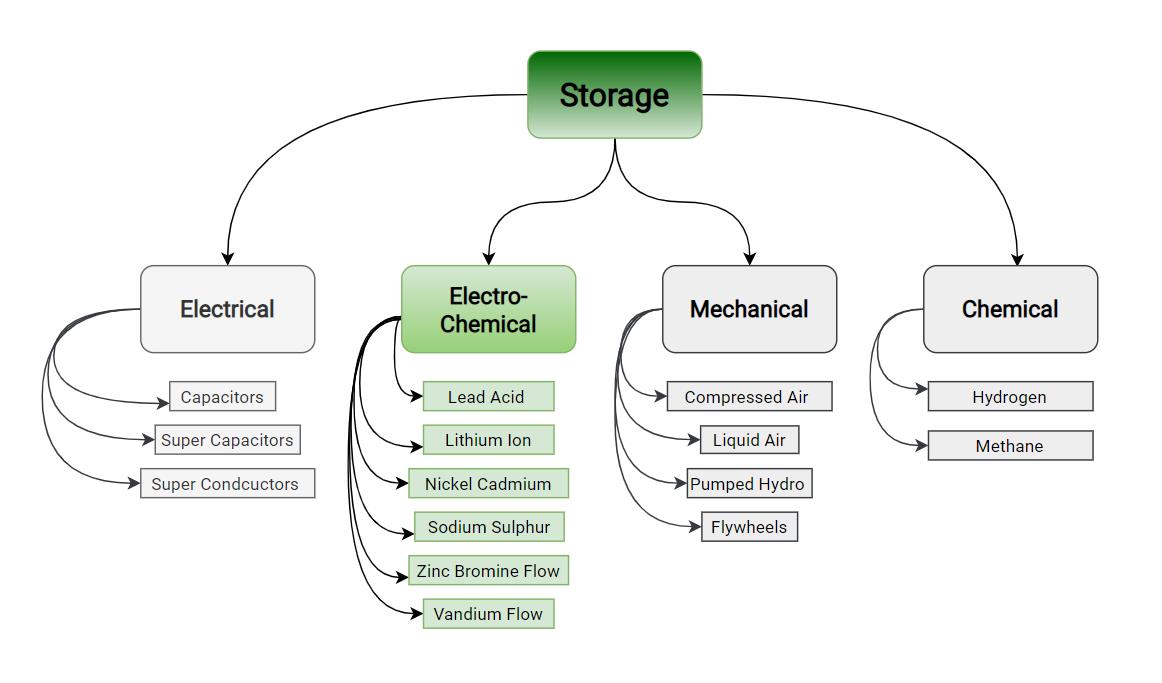
Figure 1-1: Major Energy Storage Technologies
Table 1-1: Brief Description of Energy Storage Technologies
| Storage Type |
Description |
| Description |
A component in which electrical energy is stored in an electric field is called a capacitor; whereas, if the energy is stored in a magnetic field the component becomes a super conductor magnetic energy storage device. These are used in applications where high discharge rates for smaller durations are required.
Super-capacitor and super-conductor based energy storage systems have a power range 0 – 0.3MW and 0 – 10MW, respectively. Although these technologies are not commercially viable for large scale energy storage and are continually undergoing further research for commercialisation, research suggests that these will follow suit of electro-chemical battery storage, especially for grid ancillary services such as voltage/frequency regulation and in the EV charging segment.
|
| Electro-Chemical |
Electro-chemical devices incorporate cells that undergochemical reactions resulting in conversion of chemical energy into electrical energy. The word “storage” is analogous to electro-chemical batteries due to their extensive use in powering handheld devices such as flashlights, laptops, mobile phones to high energy consumption applications such as electric cars and residential/commercial energy back up.
Batteries allow seamless charging and discharging through an electric current, which makes it easy for integration with the electric consumables. Battery storage capacities vary from a few watts to multi-MWh capacities owing to their ease in electrical connectivity. This article focuses towards understanding various battery storage technologies and their applications in large scale energy storage.
|
| Mechanical |
As opposed to electro-chemical storage systems, physical elements such as heat, water or air is used to store energy which is further converted to electrical energy with the use of complex machinery involving compressors, turbines, and generators for end consumption. Most common mechanical storage technologies include flywheels and pumped hydro storage systems. |
| Chemical |
Chemical energy storage involves storing energy chemically through an energy rich gas such as hydrogen or methane. Electrical current is passed through a chemical solution to produce hydrogen/methane which can be fed through a natural gas pipe network for use at predefined time periods. The gas is then fed to turbines coupled with generators which produce electrical energy for further consumption.
In addition to BESS, hydrogen based chemical storage is gaining swift acceptance in large scale energy storage due to negligible degradation and thermal power plant like performance.
|
Technology wise performance characteristics is tabulated in Table 1-2.
Table 1-2: Performance Characteristics of Major Energy Storage Technologies1
| Technology |
Market Maturity |
Efficiency |
Response Time |
Lifetime |
Charge Time |
Discharge Time |
Environmental Impact |
| Super-Capacitors |
In Development |
90-95% |
ms |
20+ |
s-hr |
ms-1hr |
None |
| Super-Conductor Magnetic Storage |
In Development |
95-98% |
<100ms |
20+ |
min-hr |
ms-8s |
Moderate |
| Pumped Hydro-Storage |
Mature |
75-85%/td>
| sec-mins |
40-60 |
hr-months |
1-24hrs |
Large |
| Compressed Air Storage |
In Development |
70-89% |
mins |
20-40 |
hr-months |
1-24hrs |
Large/td>
|
| Flywheels |
Semi- Commercialised |
93-95% |
ms-secs |
15+ |
s-min |
ms-15min |
None |
| Sodium Sulphur Batteries |
Commercialised |
80-90% |
ms |
10-15 |
s-hr |
s-hr |
Moderate |
| Lithium Ion Batteries |
Commercialised |
85-95% |
ms-secs |
5-15 |
min-days |
min-hr |
Moderate |
| Redox Flow Batteries |
Semi- Commercialised |
60-85% |
ms |
5-10 |
hr-months |
s-hr |
Moderate |
| Hydrogen Chemical Storage |
Demonstrated |
35-55% |
secs |
5-30 |
hr-months |
hr-months |
Production Dependent |
Based on the forecast made by Bloomberg New Energy Finance (BNEF), energy storage is expected to increase exponentially from 17GWh in 2018 to 2,850GWh by 2040. China, United States and India are expected to be subsequent leaders in the energy storage segment as illustrated in Figure 1-1.
Energy storage installations in the US touched the 3.5GWh mark alone in 2020, with the 2GWh being deployed in third quarter. Wood Mackenzie predicts that the US will add five times more storage in 2025 than the cumulative installations in 2020.China, on the other hand has added a massive 533.3MW of battery storage in the first three quarters of 2020. China has also mandated energy storage owing to the country’s renewable energy target of 16.5% out of the total energy mix. Germany is known to spearhead the renewables growth and has installed 2GWh at the end of 2019 and 2.3GWh in 2020.
Although India is not among the leaders in the battery energy storage market yet, it is estimated that 33GWh of battery storage would be required by 2032 based on the assessments conducted by ISGF (India Smart Grid Forum). Additionally, International Energy Agency’s India Energy Outlook 2021 states that India is likley to have a battery storage capacity of 140-200GWh by 2040, accounting to 30% of the world’s energy storage market. In May 2021, the Cabinet Ministry has approved a proposal of PLI scheme (Production Linked Incentive) allocating USD2.5$ billion dollars to establish a cumulative local manufacturing capacity of 55GWh. Additionally, Solar Energy Corporation of India (SECI) is leading the way for BESS integration in Solar + Storage and Round the Clock (RTC) tenders.
Furthermore, on 15 June 2021, the Central Government of India announced plans to float tenders having a cumulative battery storage capacity of 4,000MWh for the purpose of ancillary services and shall be used as support mechanisms due to fluctuation caused by renewable energy penetration in the grid. Each BESS plant shall have a maximum capacity of 1,000MWh, strategically located at each Regional Load Dispatch Center (RLDC) to provide grid support services. The tenders are also expected to have a part dedicated for time shift applications.
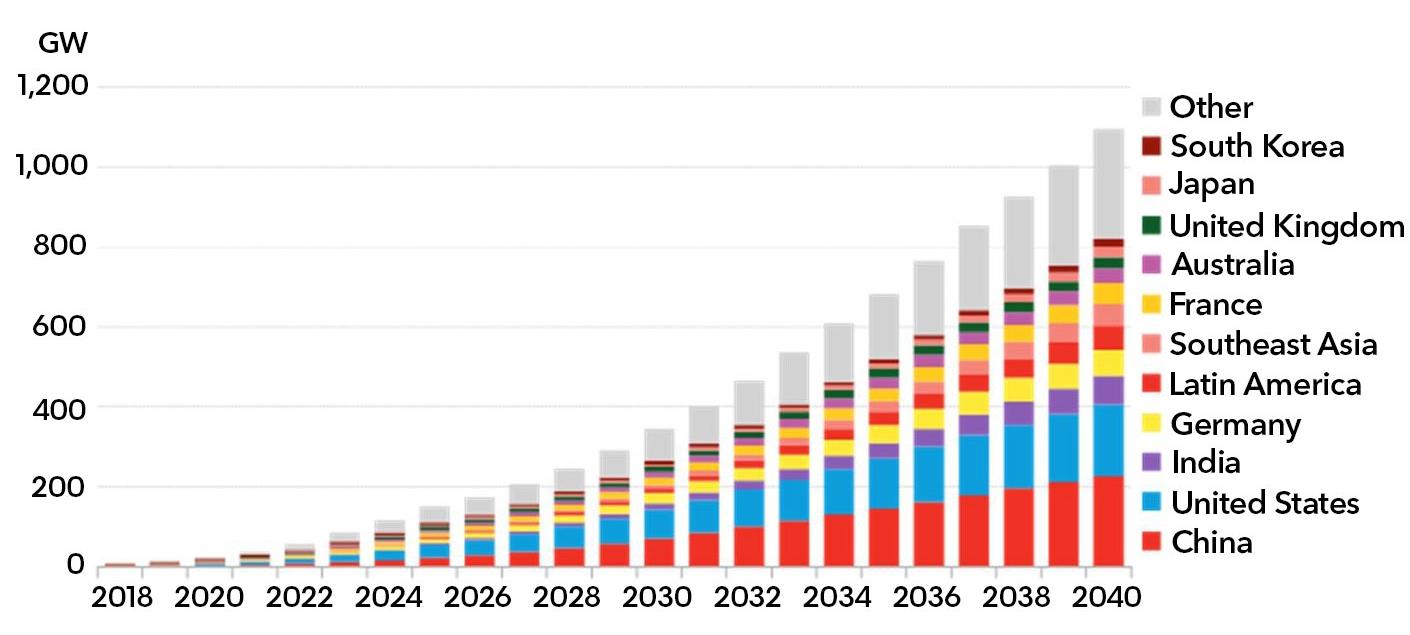
Figure 1-2: Global Cumulative Energy Storage Installations (BNEF)
Approximately $662 billion of investment is needed for the 122-fold increase in stationary energy storage. The rise in the electrochemical based storagecan be largely attributed to lithion-ion batteries owing to massive investments being made in the technology. Additionally, lithium-ion based battery packs have seen a drop in price from $668/kWh to $137/kWh from 2013 to 2020, as illustrated in Figure 1-3. This can be primarily attributed due to aggressive adoption of electric vehicles and the need to integrate VREs with batteries, especially solar generation.
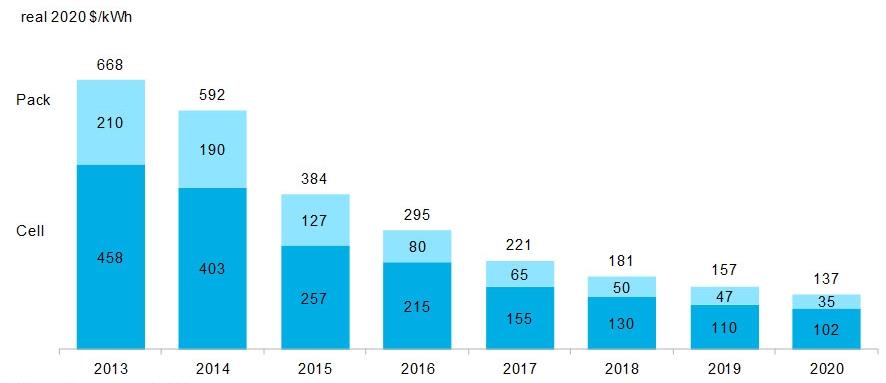
Figure 1-3: Historical Battery Pack Prices for Lithium-ion Technology (BNEF)
BNEF’s Energy Storage Outlook 2020 predicts a whopping price reduction to $101/kWh by 2023 and further to $58/kWh by 2030. The figures do not assume associatedBoS costs, various duties and soft-costs, and may therefore vary based on geography.
2. Battery Technologies
Battery Energy Storage Systems have an advantage over their counter-part storage technologies due to their distinguished flexibility, rapid response, simplemodularity, and ease in installation. Modern batteries provide long cycles, high volumetric and specific energy density, and high efficiencies for integration with variable renewable energy and various grid support services.
A simple series connection increases the voltage of battery system, whereas a parallel connection increases the current capacity. An optimal series-parallel combination of batteries further facilitates the sizing of energy capacity and power range for a specific application.
Due to their effective ramp rate and response/settling time, a single BESS system can be used for integrated applications such as energy shifting or arbitrage, frequency regulation and spinning reserve. The applications are controlled by an Energy Management System (EMS) that optimizes the charge-discharge power profiles based on user requirements. Various applications are briefly discussed in Section 3.
Batteries usually contain useful metals like high-grade copper and aluminium to base materials such as cobalt, lithium and nickel, which can be recovered based on modern recycling mechanisms. Approximately 25 – 90% of the materials can be recovered depending on separation processes.
Battery technologies differ based on the materials used for anode, cathode, and electrolytes. Commercialised and semi-commercialised battery technologies are mapped in Figure 2-1. SgurrEnergy discusses various prevalentBESS technologies, their working principles and presents antechnology specific performance comparison to understand their efficacy in grid scale storage applications.
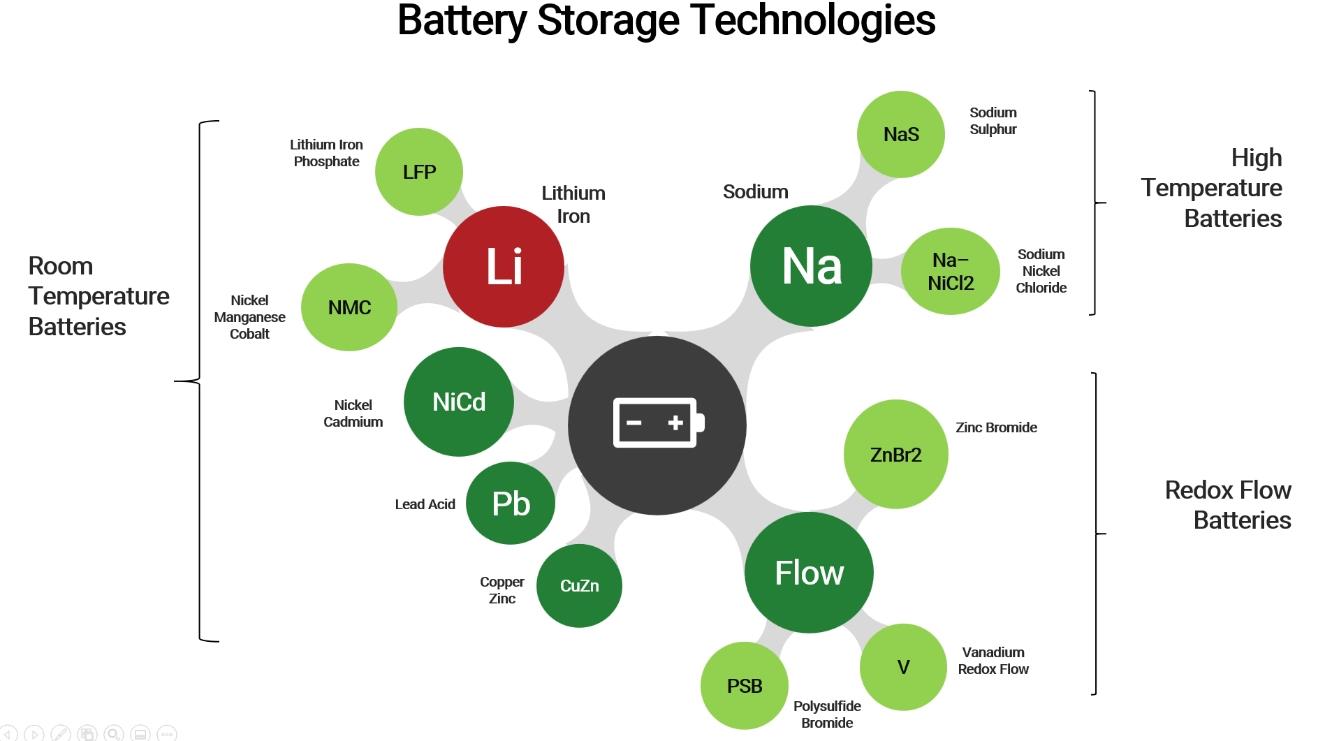
Figure 2-1: Battery Storage Technologies
2.1 BESS Major Components
BESS constitutes of various components that enable seamless grid scale storage.A typical schematic is presented in Figure 2-2 illustrating operational working, whereas Table 2-1 provides component wise functionality.
BESS primarily contains cellular storage components that directly convert and store chemical energy. Cells are combined serially to form a module which constitute of a BMS which controls and supervises individual cell functionality. Battery modules are further connected in series to form a string, thereby establishing a system voltage. Battery modules are installed in a vertical arrangement or a rack; each rack has a voltage range of 500-1500V based on available technologies. Racks are connected in parallel to increase the overall storage capacity and are housed in a single container or a block. Racks have their own BMS which directly interacts with and controls the module level BMS.
The master BMS is at the top of the battery management hierarchy and gives control signals to batteries and connects with the EMS to relay overall battery performance, status and obtain application-specific control signals. Batteries are also provided with an auxiliary support system which gives cooling functionality to the cells, as their performance is affected with varying temperatures.
A Power Conversion System (PCS) is required to convert the DC power obtained from batteries to AC power, the properties of which are defined based on grid code requirements. PCS are bi-directional power electronic devices that enable charge and discharge of battery power into the grid based on control signals obtained from the EMS.
The EMS is the primary controlling entity that interacts with all the components, provides control signals and is also responsible to monitor the performance of BESS through BMS in conjunction to generators such as VREs or thermal power plants.
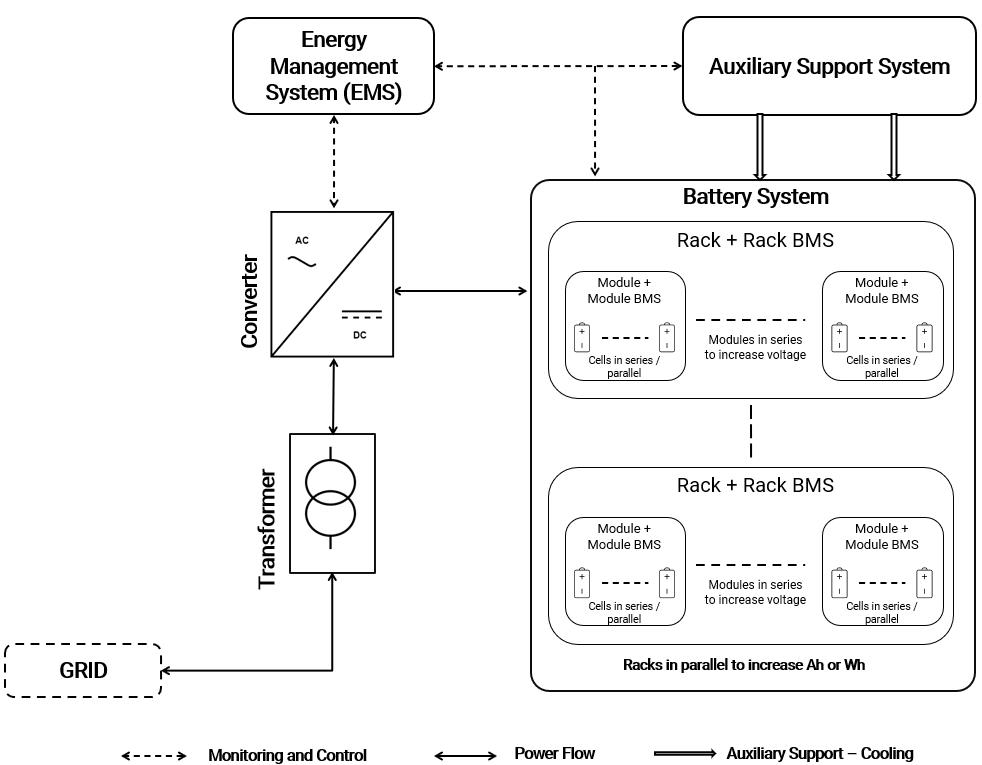
Figure 2-2: Typical BESS Schema
Table 2-1:Typical BESS Components
| Component |
Description |
| Unit Battery / Cell |
Smallest storage component within the BESS system that stores chemical energy. |
| Module / Pack / Tray |
A collection of multiple unit-batteries/cells that are electrically connected to form a larger battery pack. Each battery module constitutes of a module-BMS that continually monitors cell level voltages, currents and temperatures and performs the task of balancing the SOC of the entire module. The module-BMS receives control signals from a master-BMS or a superior controlling body within the SCADA architecture. |
| Stack |
In case of redox flow battery technologies, cells are connected in series to form a stack. |
| Racks / String |
Racks have multiple modules vertically stacked to increase the overall storage and voltage capacity. The capacities range from several kWh to few hundred kWh. Like a module-BMS, racks have rack-BMS to monitor rack-level voltage, currents and SOC and controlling and feeding information to the module-BMS. |
| Block / Battery Containers |
Allocation / Combination of several racks within a container to increase the overall capacity of energy storage. In case an internal architecture is required, a temporary building structure is constructed to include battery racks. |
| Battery System / BESS |
Parallel connection of several racks / blocks to form a larger system. The BESS rating ranges from a few kWh to hundreds of MWh. The system level BMS then interacts with the Energy Management System to obtain control signals for energy storage operation. |
| BMS |
Battery Management System (BMS) is an electronic controlling system that ensures safe operation of batteries, monitors it operational state, evaluates cell performance, receives control signals from EMS and provides results to the larger monitoring system. |
| EMS |
Energy Management System (EMS) serves as a master controller for BESS in addition to a generator. The EMS comprises of a computer based control system that enables automated control and monitoring of the PV power generated and the charging/discharging of the BESS system based on power applications envisaged for the project. |
| PCS |
Power Conversion System serves as a bi-directional power conversion device for the batteries. DC power stored in batteries is converted to AC power during discharging and vice versa during a charging cycle. |
2.2 Prevailing Battery Technologies
Batteries convert chemical energy contained in its interior active materials into electrical energy through an electrochemical redox (oxidation-reduction) reaction. Redox reactions are represented by transfer of electrons between two materials; one material is “oxidized” (loss of electrons) and the other “reduced” (gain of electrons). This entails flow of electrons from one material to another through an electric circuit. Batteries are charged and discharged by reversing the redox process.
Electrochemical cells comprise of the following major components:
- Anode / Negative Electrode / Fuel Electrode: Gives up electrons in the external circuit and is therefore “oxidized” during the redox reaction.
- Cathode / Positive Electrode: Accepts electrons from the external circuit and is therefore ‘reduced” during the redox reaction.
- Electrolyte / Ionic Conductor: Serves as a medium of transferring charge from anode to external circuit and from external circuit to cathode. Electrolytes are typically solvents, although solid electrolytes are also used in modern lithium ion solid state batteries.
Figure 2-3 illustrates the charging and discharging phenomenon in an electrochemical cell. During the discharging process, the cell is connected to an electrical load. Electrons flow from the anode, which undergoes oxidation. The electrons travel through the load and are further accepted by the cathode.
During charging, the current flow reverses and the cathode undergoes oxidation and the anode reduction. In the illustration, the change in terminology of cathode and anode should be carefully noted, although the electrodes are same. The terminology is switched due to the definition of positive and negative electrodes.
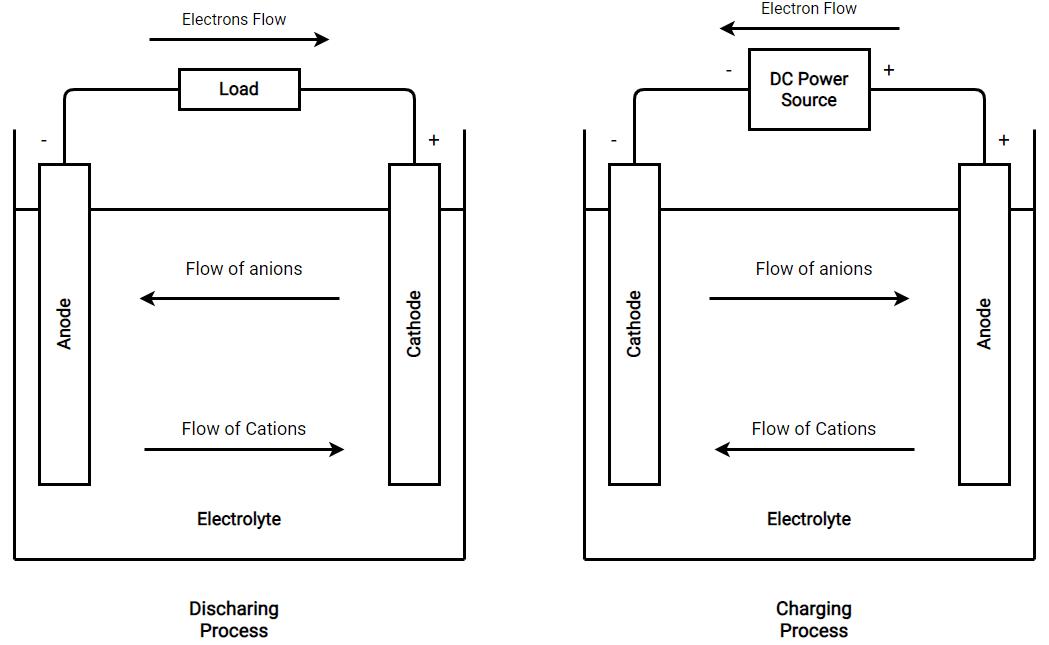
Figure 2-3: Charging and Discharging of an Electrochemical Cell
It is important to understand the principle working of commercialised battery technologies to enable an application specific, technology selection and evaluation. The following subsections briefly discuss about the materials used in various battery storage technologies and their comparative analysis.
2.2.1 Lithium Ion
Lithium ion batteries constitute of a positive electrode made of lithium oxides, negative electrode made of graphite and electrolyte including lithium salt, organic solvents, and others. Aluminium and copper act as current collectors at the electrodes. Three major lithium-ion based chemistries are tabulated2:
| Parameter |
NMC |
NCA |
LFP |
| Cathode Type |
Nickel-Manganese-Cobalt |
Nickel-Cobalt-Aluminium-Oxide |
Lithium-Iron-Phosphate |
| Cost per kWh |
++ |
+ |
- |
| Safety |
- |
-- |
+ |
| Cycle Life |
- |
- |
+ |
| Calendar Life |
+ |
+ |
+ |
| Energy Density |
+ |
++ |
- |
| Power Density |
++ |
+ |
- |
One of the major reasons the battery storage market has observed a dominance of lithium ion batteries is due to their scalability in diverse applications, specially in the electric vehicle (EV) segment. EVs in addition to grid level deployments, have created a surge in demand for lithium-ion batteries. Availability of multiple commercialised chemistries further act as a catalyst for utilisation in applications differing in power, energy, and response requirements.
2.2.2 Sodium Sulphur
Sodium-sulphur batteries constitute of molten sulphur as the positive electrode and molten sodium as the negative electrode. Electrolyte separating the electrodes is sodium alumina, a solid ceramic.Sodium sulphur batteries are categorised under high temperature batteries due to their operating temperatures between 300° to 350°C and the corrosive nature of sodium polysulfides.
These types of batteries are suited for stationary storage applications, and are not supported for EVs, therefore, in comparison to lithium-ion, sodium-sulphur batteries arenot expected to show the same growth rate. Grandview Research reports the sodium-sulphur battery market size to be a mere USD60 million in 2019 is expected to grow at a rate of 29.6% up-to 2027.
2.2.3 Redox Flow
Flow batteries includes two liquid electrolytes that are pumped into the opposite sides of a cell. The two electrolytes contain active materials in the form of metals which stay dissolved as fluids. The two electrolytes corresponding to cathodes and anodes are separately stored in tanks which are pumped into the cell; the two electrolytes are separated by an ion-selective membrane, through which the anions and cations are exchanged from anodes and cathodes, respectively.Figure 2-4 illustrates a typical arrangement of a redox cell.
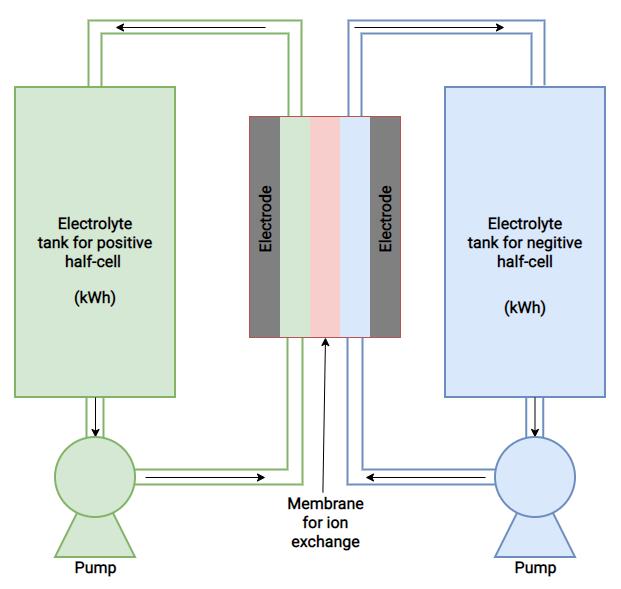
Figure 2-4: Arrangement of a Redox Cell
Power Purchase agreements are usually signed for long term periods, usually ranging from 15 to 25 years; developers usually do not like the risk to have another CAPEX infusion for battery replacement during the PPA lifecycle. Redox flow batteries owing to their highest shelf and cycle life are catching the eyes of Developers, especially in the Australian subcontinent. The overall market size for redox flow batteries was valued at USD130.4$ million in 2018 and is expected to reach USD403$ million by 2026, at a growth rate of 15.2%. Flow batteries are envisaged to be tough competitors to lithium-ion counterparts, especially in large scale stationary storage due to their long term efficacy with vanadium and zinc-bromine being prevailing chemistries.
2.3 Comparison
Noting principal materials used in various commercialised battery technologies, SgurrEnergy presents a performance based comparison in Table 3-1 and Table 3-2.
Table 2-2: Pros and Cons of Commercialised Battery Technologies.
| Technology |
Advantages |
Challenges |
| Lithium-ion |
High Energy Density
Higher Efficiency
Comparatively minimal maintenance
Broader Operational temperature
Comparatively diverse cyclic life
Faster charge-discharge rate
Availability of Multiple Chemistries to suit diverse applications
Relatively easy charge-discharge algorithms.
Abundance of Raw Materials
Rapid commercialisation and availability of multiple vendors
|
Risk of thermal runway
Requirement of advanced protective circuitry
Difficult to charge at lower temperatures.
Degradation at higher temperatures
Relatively Susceptible to aging
|
| Sodium-Sulphur |
Higher energy and power density
Relatively longer cycle life due to liquid electrodes
Capable of short-term pulses
Lower Self-discharge rates
Capable of deep discharge
High Efficiencies
Insensitive to Ambient Conditions
|
High Cost
Higher Working Temperatures (>300°C)
Highly reactive to metallic sodium
Higher O&M costs and stringent maintenance.
|
| Vanadium Redox Flow |
Longest Cycle Life (12,000+)
Longer shelf life up to 20 years.
Capable of deep discharge for short durations
Safe operation under normal operating temperatures.
|
Complex design includes pumps, sensors, and other auxiliary equipment.
Lowest energy density among commercialised technologies.
High cost of vanadium and membrane components.
|
Table 2-3: Performance of Commercialised Battery Technologies
| Parameter |
Lithium Ion |
Sodium Sulphur |
Vanadium Redox Flow |
| Energy Density (Wh/kg) |
100-250 |
150-240 |
10-50 |
| Battery Voltage (V) |
2.5-4 |
1.7-2.1 |
1-1.5 |
| Battery Efficiency |
~98% |
~90% |
~80% |
| Usage Life (Shelf Life – years) |
5-15 |
10-15 |
~20 |
| Cycle Life (cycles) |
>2,000 |
>2,500 |
>12,000 |
| Deep Discharge Ability |
Poor |
Good |
For Short Durations |
| Operational Temperature(°C) |
20-65 |
300-350 |
5-45 |
| Environmental Influence |
Less Influence |
Less Influence |
Less Influence |
| Cost (/kWh) |
~200$ – 350$6 |
~300$ – 500$ |
~100$ – 800$ |
| Recyclability Cost Impact |
Moderate |
Moderate |
Good |
| Response Time |
milliseconds |
milliseconds |
milliseconds |
3 BESS Applications
Battery characteristics and technologies presented in Section 2 and their falling prices in Figure 1-3 clearly indicates the future landscape of BESS in grid scale energy storage. It is therefore important to understand various applications BESS can cater to.
Figure 3-1 illustrates various power system applications for BESS,whereasTable 3 1presents brief details about each application. Table 3-2 presents performance requirements for relevant applications.
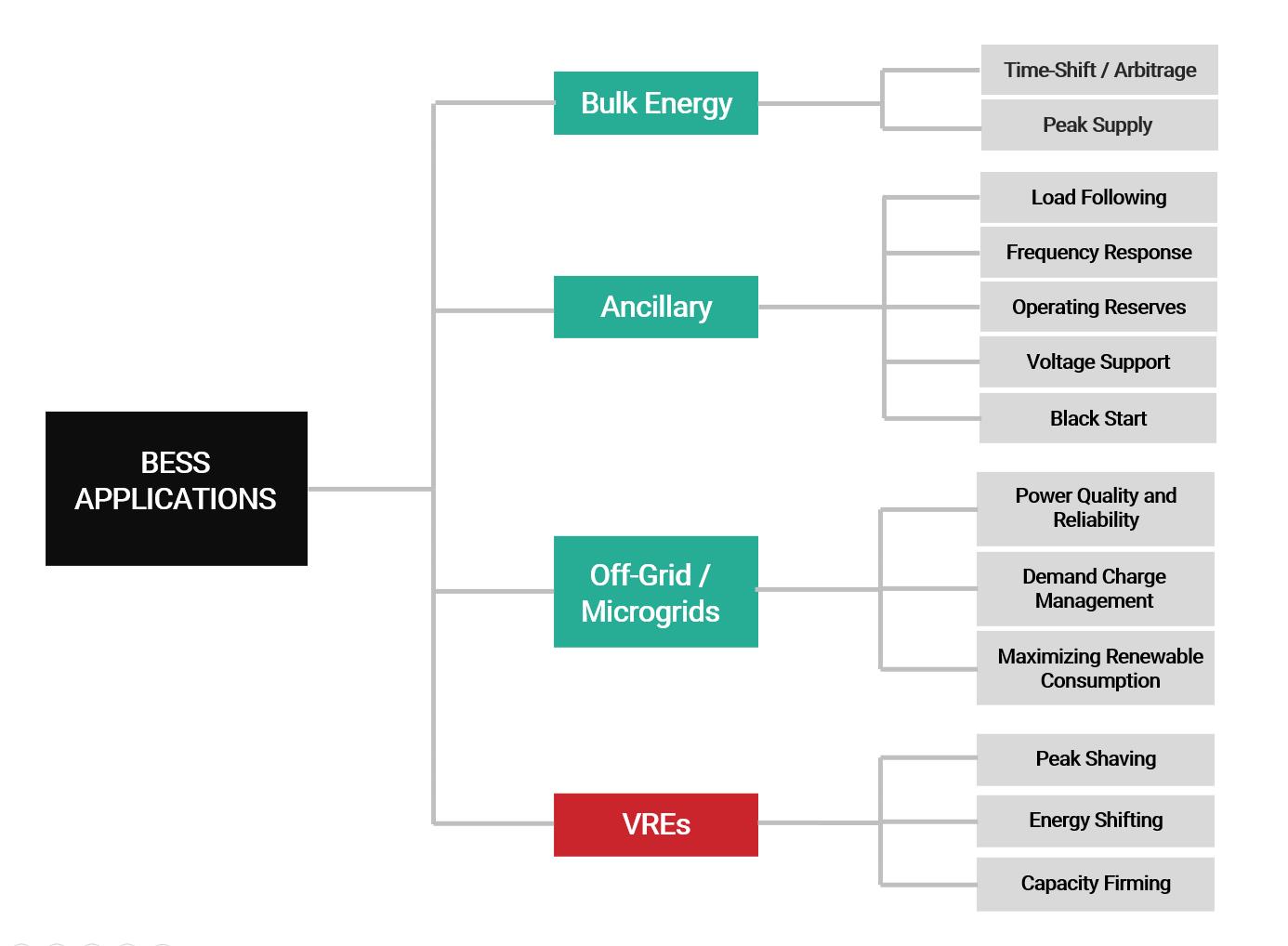
Figure 3-1: Map of BESS Applications
Table 3-1: BESS Applications in an Electrical Grid
| Application |
Type |
Description |
| Time Shifting / Arbitrage / Peak Shaving |
Vanilla BESS |
Time shift or arbitrage works on a simple principle of charging the batteries when the electricity prices are low and discharging when the electricity prices are high. For example, BESS can be charged during noon times and discharged particularly during evening periods where loads are critical. The difference in electricity prices during charge and discharge is used to optimise the revenue for BESS.
Peak shaving also a time shift application, refers to storing energy at time periods of peak power generation to avoid loss in generation due to insufficient demand and curtailment of power from generators.
BESS systems can be separately installed near large scale VREs such as wind and solar parks, charge from low-cost green energy and later dispatch at high energy arbitrage.
|
| Peak Supply |
Vanilla BESS |
Deploying BESS can reduce the need to add new central generating systems for electricity supply and/or purchase capacity in the whole scale energy market. The battery operation profile can be used as supply capacity profile based annual frequency of operation and duration.
BESS supplies a park of the peak load requirement, thereby relieving the generators and can further charge when the demand is lower.
|
| Load Following |
Ancillary |
Load following as opposed to Peak Supply / Time Shifting, operates on a more granular level where concepts like ramp rate and response rate determine the efficacy of the BESS system.
BESS is required to compensate for load variations occurring within an interconnected electrical grid network at the scale of milli-seconds. Power balancing is achieved through ‘following the load’ based on charging and discharging the batteries when the load decreases and increases, respectively.
|
| Frequency Response |
Ancillary |
An electric grid constitutes of several hundreds if not thousands of generators and millions of consumers, thereby increasing complexity in continuous operation. This causes abrupt changes in supply and demand in addition to various dynamic switching and faults occurring in this vast ecosystem. Frequency imbalance is caused due to the corresponding fluctuations, and if the variation in frequency is greater than its permissible limits, generators may disconnect from the grid and its cascading effect may result in a total blackout.
BESS can provide frequency response services by adding power to the grid when the frequency drops and charge when the frequency surges. Due to the instantaneous nature of the application the storage systems are required to operate at a millisecond scale.
|
| Operating Reserves |
Ancillary |
Some generators are kept at reserve to ensure efficient system operation in case a significant fault or a disturbance occurs or due to scheduled shutdowns. BESS can be used as spinning, non-spinning, or supplemental reserves within the power system. |
| Voltage Support |
Ancillary |
An electric grid is kept at its rated operating voltage throughout the generation and transmission hierarchy. This requires adequate reactive power management or VAR support. VAR support is crucial during peak load periods when there is significant stress on transmission and distribution lines.
BESS can be installed at strategic locations within the LV, MV or HV hierarchy which can act as a source or sink of reactive power.
|
| Black Start |
Ancillary |
During a fatal grid failure, BESS can provide backup power to energise the grid and provide a reference frequency. While this can also be coupled with a major application, where the minimum DOD / SOC should be available to enable black start. |
| Power Quality and Reliability |
Microgrids |
BESS can provide both short term reliability and long term sustainability for captive consumption applications and in microgrids.
Short term disturbances such as frequency variation, flickers, voltage, and power factor variation can be addressed by BESS in a microgrid or to a captive consumer. The power quality related applications briefed above are also applicable for mini-grids, micro-grids, and captive consumers.
Long term reliability requires that the load be supported by stored energy in BESS under frequency grid failures and/or unavailability of solar or wind power.
|
| Demand Charge Management |
Microgrids |
In this application, the tariff imposed on a captive consumer is divided into two parts: consumption charges and demand charges. Consumption charges are billed on energy (MWh); whereas demand charges are billed on power(MW).
Demand charges are applicable for peak demand periods during a monthly billing cycle; peak demand periods usually result due to unmanaged load surges from the consumer. Utilities tend to recover the cost associated with these surges for providing sufficient electricity. Some commercial consumers tend to have demand charges comprising of about 70% out of a monthly electricity bill.
BESS would be a vital addition to reduce the demand charge for large scale captive consumers, by charging when load reduces and dispatching energy during peak loading periods.
|
| Renewable Consumption Maximisation |
Microgrids |
Inexpensive energy generated by VREs, especially solar PV are usually coupled at a common connection point between the load and the utility grid. Such an arrangement is made to ensure maximum utilisation of renewable consumption; however, consumers are forced to consume from the grid when the solar resource is unavailable.
VREs such as solar PV can be oversized, and BESS can be installed in parallel to charge inexpensively from the additional solar generation and discharge when it falls short.
|
| Peak Shaving and Energy Shifting |
VREs |
A combination of VREs + BESS would further increase the viability in time shifting and arbitrage rather than having a vanilla BESS. This is mainly due to availability of cheap and economical LCoE from VREs such as solar and wind plants.
Charging from VREs and discharging during peak hours would be comparatively more lucrative than a vanilla BESS. Additionally, BESS integrated with renewables can further be used for grid support applications as listed above and facilitate and enhance grid performance.
|
| Capacity Firming |
VREs |
Solar and wind resource varies indiscriminately within a few seconds, which is far higher than the cumulative consumption variation. Since it is preferrable to have a predictable and constant power output from a generation source, BESS would certainly help stabilize the combined output.
The constant output can vary between 15-mins to a few hours based on optimal battery sizing, viz BESS Power and Energy ratings. Capacity firming is a combination of time shift, and specially ramp-rate control, usually expressed as %Power/Minute.
|
|
|
|
Table 3 2: BESS Performance Requirements in Grid Scale Applications7
| Application |
Type |
Power Range |
Expected Response Time |
Discharge Duration Range |
Charge-Discharge Cycles Per Year |
| Time Shifting / Arbitrage |
Vanilla BESS |
1MW to 1GW |
milliseconds to minutes |
2hours to 6hours |
>250 |
| Peak Supply |
Vanilla BESS |
1MW to 1GW |
minutes |
2hours to 6hours |
50 to 360 |
| Load Following |
Ancillary |
1MW to 100MW |
less than 1s |
15minutes to 4hours |
250 to 10,000 |
| Frequency Response |
Ancillary |
20MW to 50MW |
milliseconds to second(s) |
few seconds to few minutes |
~200 |
| Operating Reserves |
Ancillary |
10MW to 100MW |
milliseconds to second(s) |
minutes to hours |
50 to 365 |
| Voltage Support |
Ancillary |
1MVAr to 100MVAr |
milliseconds to seconds |
few minutes to an hour |
Geography Dependent |
| Black Start |
Ancillary |
5MW to 50MW |
minutes |
seconds to hours |
10 to 20 |
| Power Quality |
Microgrids |
1MW to 10MW |
milliseconds |
Seconds to minutes |
100 to 10,000 |
| Power Reliability |
Microgrids |
1MW to 250MW |
milliseconds |
minutes to hours |
10 to 400 |
| Demand Charge Management |
Microgrids |
10kW to 10MW |
seconds to minutes |
15minutes to 4hours |
50 to 500 |
| Renewable Consumption Maximisation |
Microgrids |
10kW to 10MW |
seconds to minutes |
15minutes to 4hours |
200 to 500 |
| Peak Shaving |
VREs |
1MW to 1GW |
milliseconds to minutes |
2hours to 8hours |
>250 |
| Energy Shifting |
VREs |
1MW to 1GW |
minutes |
2hours to 8hours |
50 to 360 |
| Capacity Firming |
VREs |
1MW to 500MW |
milliseconds to minutes |
2hours to 6hours |
>250 |
Although, the intention of this paper is to introduce BESS technologies and its applications, SgurrEnergy will be realising various papers for each major application with its relevance in stationary energy storage segment.
4. Services offered by SgurrEnergy
| Service Head |
Description |
| Feasibility, Energy Modelling and Analysis |
SgurrEnergy’s experienced analysis team is capable of modelling storage systems in conjunction with other variable energy resources such as wind and solar.
Usage of cell specific chemistry determines the overall performance and yield of a storage project; SgurrEnergy accounts in the analysis component specific performance model and chemistry in the simulation. In addition to the chemistry, battery specific loss models and thermal response is also accounted to accurately simulate storage performance.
Long term storage profile for understanding the impact of life cycles on the storage capacity along with smaller simulation intervals such as 1ms to 30 minutes accurately determines the effective utilisation of battery storage systems for various stationary storage applications. This includes the modelling of battery degradation, therefore aiding in selecting the best performing storage technology.
Sub-hourly yield assessments are generated in parallel with the solar and wind generation profiles, to understand the efficacy and efficiency of battery storage integration with solar/wind power plants.
The analyses can be conducted for various storage applications and business models such as
Frequency Regulation
Ramp Rate Control
Black Start Services
Storing Clipping Energy
Storing Curtailed Energy
Energy Shifting / Arbitrage
Transmission and Distribution Relief
|
| Technology Assessment |
Batteries being a relatively dynamic technology, undergoes various materialistic and design advances to enhance overall performance and reliable operation. The dynamic changes in manufacturing results in wavering confidence among various developers and lenders to select an appropriate battery technology. SgurrEnergy’s battery technology assessment and review services include the following
Modelling and analysis of various battery technologies incorporating cell chemistry, thermal behaviour, degradation, and loss associated with power equipment.
Consideration of financial KPIs such as the CAPEX, OPEX and the LCOE for selecting a particular battery technology to understand the commercial impact on the Project.
Review of test reports and certifications to adherence with national and international standards.
Review of warranty documentation to keep the Project safe for better long term performance.
Preparation of associated project deliverables for project bidding and design optimisation purposes.
|
| Detailed / Owner’s Engineering |
Detailed engineering includes conceptualisation and design optimisation including the following:
Infrastructure Planning
Civil Structural Engineering
Hydrology Studies
Electrical Engineering
Mechanical Engineering
This includes a pool of Subject Matter Experts from engineering, data analysis and BESS segments to design projects efficiently and optimally.
|
| Performance Analysis |
SgurrEnergy offers independent operational assessment and detailed performance analyses for existing BESS assets and VRE integrated with BESS portfolios. This aids in comparison of expected performance v/s actual performance of systems thereby enabling a thorough assessment of various reasons pertaining to underperformance and identification of suitable mitigatory measures to increase the overall efficiency of the assets. The following services can be undertaken by SgurrEnergy under operational performance analysis.
Detailed modelling and as-built simulation of components comprising a BESS system.
Comparison of simulated/expected performance v/s actual performance over key performance indicators such as charge-discharge currents, cell-degradation and SOC / DoD variation.
A thorough evaluation of round-trip efficiencies, power converter modelling for losses and prediction of remaining capacities of the cells.
Site Visits and formulation of testing required to increase the asset performance.
Identification of additional maintenance needs resulting from the analyses for effective utilisation of BESS assets.
|
| EPC Bid Management |
After the feasibility of the project is established, there comes a need of evaluating and selecting the EPC or specialized contractors, with proven capabilities to perform the engineering, procurement, and construction of solar PV projects of the developers. And for this major requirement, solar engineering consultants extend bid management services to review contracts for ensuring these are complete, consistent, and technically sound and in return can help selecting the best EPC or specialized contractors for the project. |
| Bankability Studies |
Review of company background, historical track record and evaluation of products for market use cases.
Verification and evaluation of manufacturing processes, usage of basic input materials, supply chain management, packing, storage, and end testing of products.
Evaluation of product technical characteristics, performance test reports and reliability test reports.
Review of warranty and claim management documents, product certifications and adherence to international standards.
|
Download as PDF